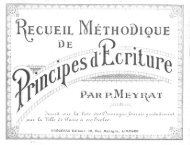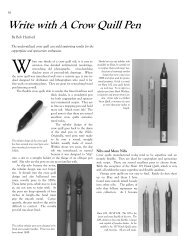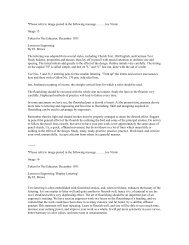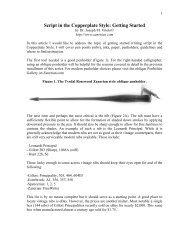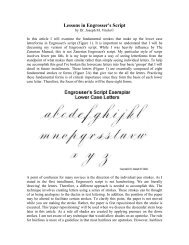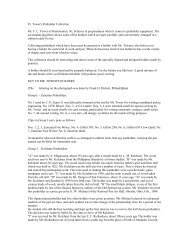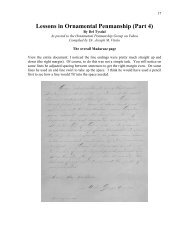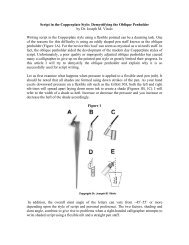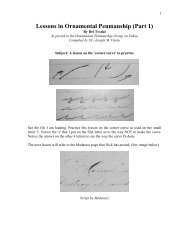The Educator (Volume 45) - IAMPETH
The Educator (Volume 45) - IAMPETH
The Educator (Volume 45) - IAMPETH
Create successful ePaper yourself
Turn your PDF publications into a flip-book with our unique Google optimized e-Paper software.
A Lesson on Slant and Alignment<br />
From the San Francisco Public Schools Monthly Bulletin<br />
Demonstration Lesson given by MISS THYRZA WALTERS. Grattan Elementary School<br />
Welcome by Miss Mary Reene, Principal<br />
It is a very great pleasure to again<br />
bi' with the probationary teachers<br />
anil to greet some of my old friends<br />
as well. <strong>The</strong> purpose of today's lesson<br />
is to demonstrate how slant<br />
and alignment can be accomplished<br />
through correct position with particular<br />
emphasis on correct position of<br />
body, paper and pen. <strong>The</strong> lesson will<br />
last fifteen minutes. <strong>The</strong>re are<br />
thirty-eight pupils in this 4A grade.<br />
Every child is present. No one has<br />
been excused, for we are endeavoring<br />
to show how left-handed children, new<br />
children, and children lacking perfect<br />
bodily coordination are handled in a<br />
classroom. <strong>The</strong> writing products will<br />
consequently vary to a marked degree.<br />
This lesson is on the technique of<br />
writing, and any lesson dealing with<br />
the mechanics of a subject and the<br />
handling of tools has to be more or<br />
less definite and consequently formal.<br />
As soon as the proper habits have<br />
been established this formality is<br />
abandoned.<br />
As the lesson progresses, the class<br />
will be grouped according to accomplishment.<br />
<strong>The</strong> first two rows have<br />
been promoted twice: first from the<br />
"position group" to the "slant group,"<br />
and then to the "form group." <strong>The</strong><br />
second two rows compose the "slant<br />
group" and have been promoted from<br />
the "position group." <strong>The</strong> middle<br />
rows are the "position group" and<br />
are woiking to be promoted before<br />
the end of the term.<br />
I wish you to know that we do<br />
not aspire in this grade to perfection<br />
of form. We do hope for lightness<br />
of line, freedom of movement, and<br />
correct writing habits. I think no<br />
teacher is so apt to get discouraged<br />
as is the fourth grade teacher. She<br />
appears to get so little result from<br />
the energy expended. I think you<br />
will agree when viewing the papers<br />
after the lesson and seeing their exhibit<br />
of writing in the upper hallway,<br />
that these little people have attained<br />
slant, lightness of line, swing and<br />
freedom.<br />
Here in the front of the room is a<br />
little puppet show that has evolved<br />
from a unit on Aquatic Life. <strong>The</strong><br />
wi'iting chart in that room follows<br />
out the unit, the varying depths of<br />
the ocean representing degrees of attainment<br />
on the Ayres Scale with<br />
each child in the room represented<br />
by his favorite fish. <strong>The</strong>se ai'e movable<br />
and are moved to show progress.<br />
You are cordially invited to visit all<br />
of the classrooms. I would also call<br />
your attention to the charts in all of<br />
the rooms showing the monthly rating<br />
on the Ayres Chart. <strong>The</strong>se charts<br />
have been very helpful to us and I<br />
hope prove suggestive to you.<br />
I am now going to turn the meeting<br />
over to Miss Walters, my very<br />
excellent and enthusiastic fourth<br />
grade teacher.<br />
Miss Walters: What shall be our<br />
aim today, girls and boys ?<br />
Aeriel: We want to work to hold<br />
our pens correctly.<br />
I-ouis: We need form.<br />
Any teacher can acquire a<br />
fair degree of proficiency<br />
in his own handwriting,<br />
and learn enough about the<br />
mechanics of handwriting<br />
in order that he may direct<br />
a pupil to change from<br />
careless work to the kind<br />
that is neat, legible, and ex-<br />
ecuted at a sufficient rate of<br />
speed. Careless writing<br />
from a teacher is as much<br />
a confession of poor preparation<br />
as is slovenly<br />
grammar or poor pronunciation,<br />
and as unbecoming<br />
and unprofessional.<br />
Francis: We need to write straight<br />
across the paper.<br />
John: We need to push and pull<br />
our papers as we write across the<br />
page.<br />
Eleanor: We must try not to go<br />
down hill.<br />
Helen: We need more slant.<br />
Miss Walters: We need all of these<br />
things—but today we are going to<br />
work for alignment only. If we have<br />
correct position, it is easy to get slant<br />
and alignment. We must have good<br />
position. Think of your feet. Bend<br />
your body slightly forward. Place<br />
the arms properly on the desk. Place<br />
pens in correct position. It will tell<br />
you how to place your paper to attain<br />
alignment. Keep your hands in<br />
correct position. Put the paper on<br />
the desk. Imagine a line extending<br />
from the inkwell to the opposite corner<br />
of the desk. If you place your<br />
paper correctly you will be able to<br />
15<br />
write straight across the paper. We<br />
have a special drill to help us keep<br />
our paper in a parallel position.<br />
(Teacher indicates shifting of the<br />
paper on the blackboard.) It is 1, 2,<br />
a, 4, pull; 1, 2, 3, 4, push; 1, 2, 3,<br />
4, pull; 1, 2, 3, 4, push. Thus we are<br />
able to write straight across the<br />
paper. Sometimes this happens. (In<br />
the shifting, the teacher turns the<br />
paper so that it is no longer parallel<br />
with the diagonal line of the desk.)<br />
What happened to my line, Caroline ?<br />
Caroline: You went down hill.<br />
Miss Walters: Who can tell me<br />
why I went down hill ?<br />
Ruth: You had too much slant to<br />
ycuir iiaper.<br />
Miss Walters: Sometimes this happens<br />
(In the shifting, teacher turns<br />
the paper so that it is no longer<br />
l)arallel with the diagonal line of the<br />
desk.) 1, 2, 3, 4, pull; 1, 2, 3, 4, push.<br />
What happened to that line.<br />
Dorothy : You went up hill.<br />
Miss Walters: Can you tell me<br />
why I went up hill ?<br />
Dorothy Ann: You did not have<br />
enough slant.<br />
.Miss Walters: If we know what<br />
causes the trouble we can avoid it.<br />
Place the paper parallel with the imaginary<br />
line about one and one-half<br />
inches from your ink well. We will<br />
now have the dry pen exercises.<br />
Verna please count.<br />
Verna: 1, 2, 3, 4, pull; 1, 2, 3, 4,<br />
push; 1, 2, 3, 4, pull; 1, 2, 3, 4, push.<br />
( Children use dry pen drill following<br />
instructions on shifting.)<br />
Miss Walters: Fine! Dip your<br />
pens in the ink. We will just make<br />
a line from left to right and see that<br />
this line goes straight across the<br />
paper. All count.<br />
All: 1, 2, 3, 4, pull; 1, 2, 3, 4, push;<br />
1, 2, 3,'"4, pull; 1, 2, 3, 4, push. (<strong>The</strong><br />
teacher passes up and down the aisles<br />
noting accomplishment and making<br />
needed comments such as "Light<br />
lines" "Watch your pen.")<br />
Miss Walters: Let us stop and look<br />
at our papers. Who went dowm hill?<br />
Mary: I did.<br />
Miss Walters: Why?<br />
Mary : My paper had too much<br />
slant.<br />
Miss Walters: Who went up hill?<br />
Burnett: My paper did not have<br />
enough slant.<br />
Miss Walters: Let us put a little<br />
check on the imperfect lines and try<br />
again. One more line. All count.<br />
Miss Walters: Now, we will stop.<br />
This is a lovely paper (holds up a



